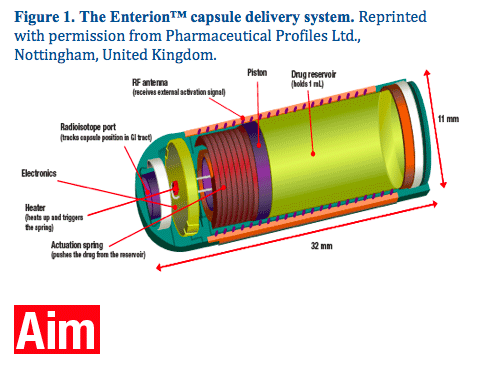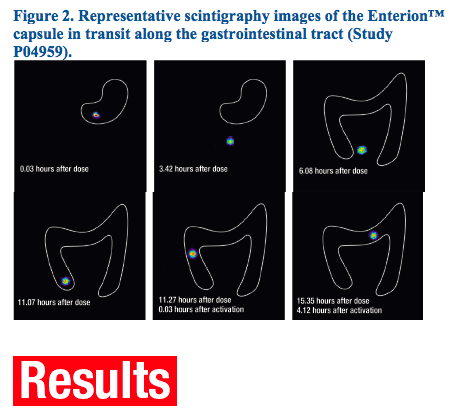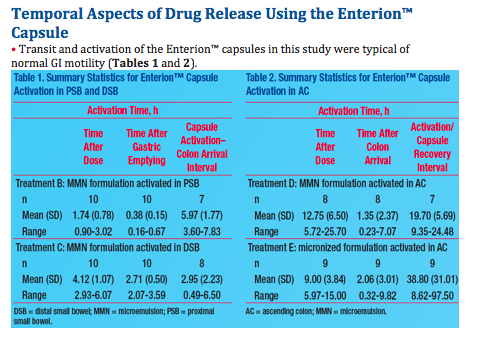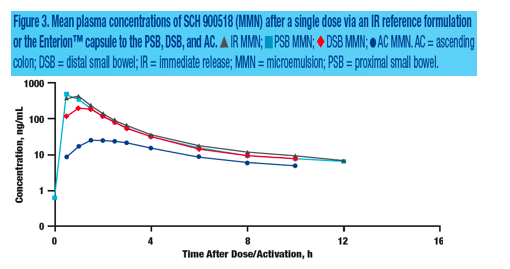 |
 |
 |
| |
A Regional Gastrointestinal Absorption Study of the HCV NS3 Protease Inhibitor SCH 900518 in Healthy Volunteers: "remote-controlled drug delivery device that delivers any form of drug to key regions of the human gastrointestinal (GI) tract."
|
| |
| |
44th EASL April 23-26 2009 Copenhagen Denmark
Reported by Jules Levin
E. A. Hughes,1 Y. Wan,1 M. A. Treitel,1 S. Gupta,1 C. Hu,1 B. Yue,1 A. Sheth,1 M. Corpus,1 D. Marchisin,1 P. Prasad,1 E. O'Mara,1 J. de Bres,2 A. Connor,2 K. Palaniappan2
1Schering-Plough Research Institute, Kenilworth, New Jersey, USA; 2Pharmaceutical Profiles Ltd., Nottingham, United Kingdom
Author Conclusions
SCH 900518 (100 mg) administered as a single dose was safe and well tolerated.
- Absorption of SCH 900518 (MMN) after delivery to the PSB was similar to that of the administration of the IR formulation.
- Absorption of SCH 900518 (MMN) was slightly lower after delivery to the DSB compared with administration of the IR formulation.
- Rate and extent of absorption of SCH 900518 (MMN) were reduced after delivery to the colon compared with administration of the IR formulation.
- Delivery of the micronized formulation of SCH 900518 to the colon resulted in no detectable absorption.
Rate and extent of absorption of SCH 900518 (MMN) were decreased as the formulation was delivered more distally in the GI tract.
Abstract
Background: SCH 900518, a novel hepatitis C virus (HCV) nonstructural protein 3 (NS3) protease inhibitor, demonstrates potent antiviral activity with an EC90 of 40 nM in the in vitro HCV replicon assay. This study investigated the relative bioavailability of SCH 900518, when delivered to the small bowel and ascending colon (AC), in comparison to an immediate-release (IR) formulation to help guide the development of an extended-release formulation.
Methods: This was a randomized, crossover, open-label study of SCH 900518 conducted in healthy volunteers. This study employed the Enterion™ capsule system, a unique remote-controlled drug delivery device that delivers any form of drug to key regions of the human gastrointestinal (GI) tract. During each of the five periods, 10 subjects received 1 of 5 100-mg single-dose treatments: IR reference formulation of SCH 900518 (microemulsion), Enterion™ delivery of SCH 900518 (microemulsion) to the proximal small bowel (PSB), Enterion™ delivery of SCH 900518 (microemulsion) to the distal small bowel (DSB), Enterion™ delivery of SCH 900518 (microemulsion) to the AC, and Enterion™ delivery of SCH 900518 (micronized) to the AC.
Results: Ten subjects enrolled in the study and 2 subjects discontinued for non-AE-related reasons. Plasma concentrations of SCH 900518 (microemulsion) were similar following administration of an IR formulation and delivery to the PSB, while exposure of SCH 900518 (microemulsion) was slightly lower following administration to the DSB. The rate and extent of absorption of SCH 900518 (microemulsion) were significantly reduced following delivery to the colon. Delivery of the micronized formulation of SCH 900518 to the colon resulted in no detectable absorption (concentrations < LLQ). The relative bioavailability of the SCH 900518 (microemulsion) was highest when delivered in the PSB (99.2%), followed by in the DSB (66.0%), and lowest (20.2%) in the AC.
Conclusions: SCH 900518 was safe and well tolerated as single doses in healthy adult subjects. The rate and extent of absorption of SCH 900518 are decreased as the formulation is delivered more distally in the GI tract.
Note: Abstract has been updated since submission.

· SCH 900518 is a potent, orally administered, novel serine protease inhibitor specifically designed to inhibit the hepatitis C virus (HCV) nonstructural protein 3 (NS3) protease.
· Experience with other HCV NS3 protease inhibitors suggests that efficient suppression of HCV viral replication is dependent on the maintenance of trough plasma concentrations greater than the EC90 of the compound.
· Formulations that can delay the absorption of the compound or that can use multiple sites of absorption throughout the gastrointestinal (GI) system may be beneficial.
· This regional absorption study was designed to investigate the feasibility of extending the in vivo release of SCH 900518 and to suggest strategies for further development of the formulation.
· The Enterion™ capsule system is a unique remote-controlled drug delivery device that delivers any form of drug to key regions of the human GI tract (Figure 1).
- This device ensures that the entire contents of the capsule are deposited precisely where required.
--- Delivery is achieved without the need for invasive measures that can disrupt local physiology and affect data accuracy.

· To assess the bioavailability of SCH 900518 in portions of the GI system that may have the greatest relative differences in absorption (proximal small bowel [PSB], distal small bowel [DSB], and ascending colon [AC]).
- The primary objective was to investigate the relative bioavailability of SCH 900518, when delivered to the small bowel and AC, compared with an immediate-release (IR) formulation.
- The secondary objective was to investigate the safety and tolerability of SCH 900518.

· This was a randomized, crossover, open-label study of SCH 900518 conducted in healthy adult female volunteers.
· Ten subjects were enrolled in a single cohort.
Study Design
· The design consisted of 5 study periods. Each subject received 1 of 5 treatment regimens according to a randomized treatment sequence:
- Treatment A: IR reference formulation of 100 mg SCH 900518 (microemulsion [MMN])
- Treatment B: Enterion™ delivery of SCH 900518 (100 mg) to the PSB (MMN)
- Treatment C: Enterion™ delivery of SCH 900518 (100 mg) to the DSB (MMN)
- Treatment D: Enterion™ delivery of SCH 900518 (100 mg) to the AC (MMN)
- Treatment E: Enterion™ delivery of SCH 900518 (100 mg) to the AC
(micronized)
· Scintigraphy was used to monitor the transition of the Enterion™ capsules along the GI tract and to confirm the capsule activation site (Figure 2).
- Small bowel activation: images were recorded at approximately 10-minute intervals until capsule activation, then at approximately 20-minute intervals for 8 hours or until arrival in the transverse colon.
--- Ascending colon activation: images were recorded at approximately 20-minute intervals until gastric emptying, then at approximately 10-minute intervals until capsule activation, and finally at approximately 20-minute intervals for 4 hours after activation or until capsule defecation.

Demographic Characteristics
· Ten healthy volunteers were randomly assigned in this study.
- All subjects were white women.
- Ages ranged from 18 to 59 years.
- Mean body mass index was 25.28 kg/m2 (range, 20.2-32.5 kg/m2).

Pharmacokinetics of SCH 900518
· Absorption of SCH 900518 (MMN) was similar after administration of an IR formulation and delivery to the PSB (Figure 3).
- In addition, absorption of SCH 900518 (MMN) was slightly lower after delivery to the DSB than it was after administration of the IR formulation.
· Rate and extent of absorption of SCH 900518 (MMN) were lower after delivery to the colon than they were after administration of the IR formulation.
--- Delivery of the micronized formulation of SCH 900518 to the colon resulted in no detectable absorption.

· Pharmacokinetic parameters according to site of activation are shown in Table 3.
· Relative bioavailability of SCH 900518 (MMN) was highest when delivered to the PSB (99.2%), next highest when delivered to the DSB (66.0%), and lowest (20.2%) when delivered to the AC.

Safety
· Six (60%) subjects experienced at least 1 treatment-emergent adverse event (AE).
- Headache was the most commonly reported treatment-emergent AE (n = 4; 40%).
- No subject withdrew from the study because of an AE.
- All other treatment-emergent AEs occurred in 1 or fewer subjects.
· No deaths or serious AEs and no clinically significant changes occurred in blood chemistry or hematologic parameters, vital signs, or electrocardiograms.
|
| |
|
 |
 |
|
|